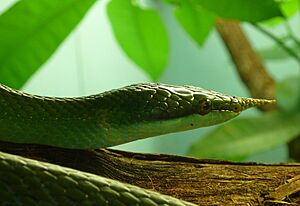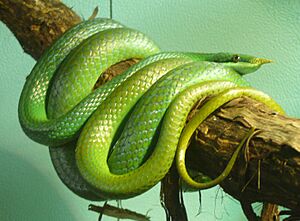Rhinoceros ratsnake facts for kids
Quick facts for kids Rhinoceros ratsnake |
|
|---|---|
 |
|
| Conservation status | |
| Scientific classification | |
| Genus: |
Gonyosoma
|
| Species: |
boulengeri
|
| Synonyms | |
|
|
The rhinoceros ratsnake (Gonyosoma boulengeri) is a cool snake known for its unique 'horn' on its nose! People also call it the rhinoceros snake, rhino rat snake, or Vietnamese longnose snake. This snake is not venomous, meaning it's not dangerous to people. It belongs to a group of snakes called ratsnakes. You can find these special snakes in northern Vietnam and southern China. Its nose horn looks a lot like a rhinoceros horn, which is how it got its name!
Contents
What's in a Name?
The second part of the snake's scientific name, boulengeri, honors a famous biologist. His name was George Albert Boulenger. He was a Belgian-British scientist who studied many animals.
Where Do They Live?
Rhinoceros ratsnakes live in northern Vietnam and southern China. For example, they have been seen in a place called Tam Dao in Vietnam. In 2001, scientists found 10 of these snakes in Yên Bái Province, which is also in northern Vietnam.
Snake Features
Adult rhinoceros ratsnakes can grow quite long. They are usually between 100 and 160 centimeters (about 3 to 5 feet) in total length. This measurement includes their body and tail. They have 19 rows of scales along their back in the middle of their body.
Life in the Wild
Rhinoceros ratsnakes live in warm, wet subtropical rainforests. They prefer areas with streams and can be found at heights between 300 and 1100 meters (about 1,000 to 3,600 feet) above sea level.
Daily Life and Diet
These snakes usually live in trees. They are active during the day, which means they are diurnal. They hunt for food like small mice and other rodents. They also eat birds and maybe other small animals with backbones.
Reproduction and Life Cycle
Rhinoceros ratsnakes lay eggs. This means they are oviparous. Their mating season is usually from April to May. A female snake can lay a clutch of five to 10 eggs.
The eggs hatch after about 60 days. Baby snakes are born about 30 to 35 centimeters (about 12 to 14 inches) long. When they are young, they are brownish-grey. They also have dark edges on some of their back scales.
As they get older, their color changes. At about 12 to 14 months old, they turn a steel grey color. Then, around 24 months old, they become a bluish-green or green. This is their adult color. However, a few rare snakes stay steel grey and do not change to the adult colors.
What's the Nose Horn For?
Scientists have studied the unique nose horn on these snakes. Some studies suggest that male snakes might use it for mating displays. They might 'fence' with their horns to show off to rivals. Other studies have not found a strong link between the horn and courtship. This means we still don't fully know what the horn's main purpose is!



